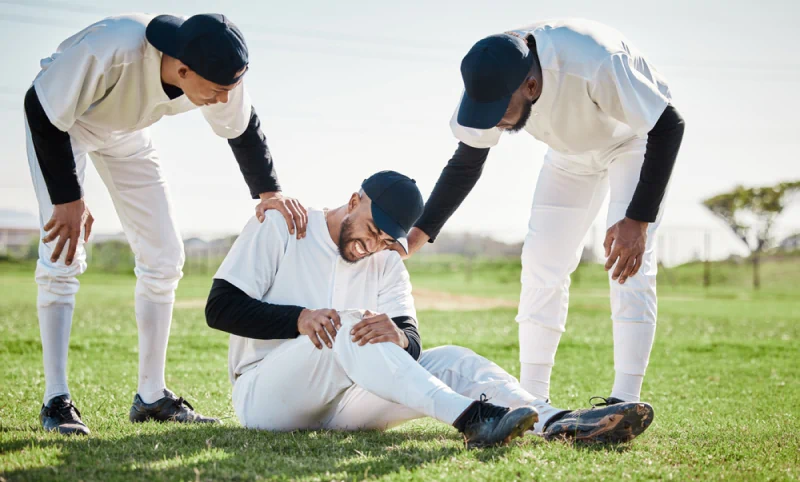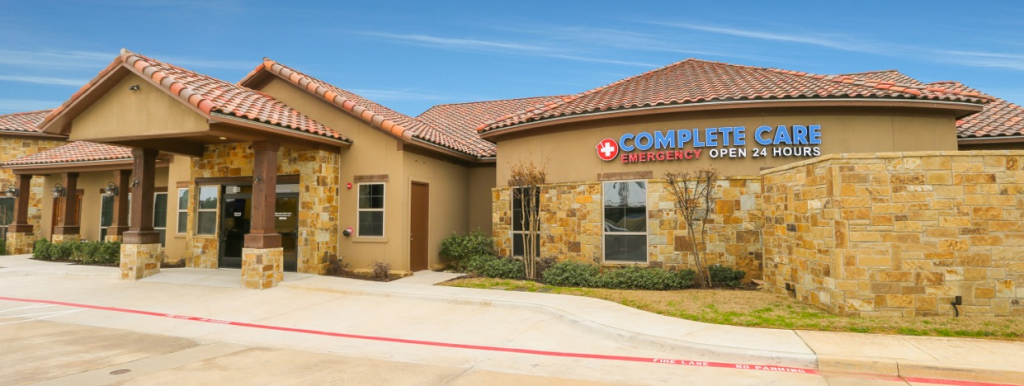What are the Most Common Baseball Injuries?
Sports Injuries
•
May 4, 2024

Although baseball may be our nation’s most beloved sport, like any physical activity, lacing up your cleats and taking to the diamond does carry a baseline risk of injury. Baseball injuries can run the gamut, ranging from minor sprains and strains to more serious conditions requiring surgical intervention.
Here are 8 of the most common baseball injuries faced by players young and old:
- Rotator Cuff Tears
- Ulnar Collateral Ligament (UCL) Injuries
- Meniscus Tears
- Concussions
- Hamstring Strains
- Pitchers Elbow (Medial Epicondyle Apophysitis)
- Hand Injuries
- Dead Arm (Shoulder Instability)
Each of these injuries in baseball has its own causes, symptoms, and treatment methods. In the following blog post, we will dive deeper into each injury listed above, exploring causes, how they affect players, and injury prevention strategies. Whether you’re a player yourself, a coach, or just a fan of the game, understanding these common injuries is essential for anyone who loves America’s favorite pastime.
1. Rotator cuff tears
Rotator cuff tears are one of the most common baseball shoulder injuries, particularly for pitchers, caused by the repetitive and high-speed motions involved in throwing.
The rotator cuff is a group of muscles and tendons that stabilize the shoulder and facilitate its movement. A tear can range from minor strains, which might require rest and physical therapy, to complete tears that necessitate surgical repair.
Symptoms of a rotator cuff tear include:
- Pain when lifting the arm
- Weakness in the shoulder
- Crackling sensation when moving the shoulder in certain positions
Prevention strategies involve proper warm-up routines, strength training focusing on the shoulder, and ensuring proper throwing mechanics to reduce stress in the area. For those who suffer from this injury, treatment options vary depending on the severity but can include rest, ice, anti-inflammatory medication, physical therapy, and in more severe cases, surgery followed by a significant rehabilitation period.
2. Ulnar collateral ligament (UCL) injuries
Ulnar collateral ligament (UCL) injuries are another one of the most common injuries in baseball, once again particularly affecting pitchers. UCL injuries are becoming more and more common in college ball and the major leagues, many believe because of increasing velocity and pitch clocks being instituted in high-level ball.
The UCL is a ligament on the inner side of the elbow, and injuries occur from the overuse and strain of repetitive pitching motions. A well-known treatment for a significant UCL injury is Tommy John surgery, named after the first baseball player to undergo the procedure. This surgery involves replacing the damaged UCL with a tendon from elsewhere in the body, usually from a forearm or a hamstring.
Symptoms of UCL injuries include:
- Pain on the inside of the elbow
- A popping sensation during the throwing motion
- Decreased throwing velocity
- Instability in the elbow
Preventative measures include limiting pitch counts, especially for younger athletes, ensuring adequate rest between pitching sessions, and proper conditioning and strengthening of the arm muscles.
For those who sustain a UCL injury, initial treatments often focus on rest, ice, and anti-inflammatory medications. Physical therapy may also help to strengthen surrounding muscles and support elbow healing. In cases where conservative treatments fail, surgical intervention may be necessary to restore full function to the elbow.
3. Meniscus tears
Meniscus tears are common injuries among athletes who engage in sports requiring sudden turns and stops, such as soccer, basketball, and tennis, making them one of the most common sports injuries.
The meniscus is a piece of cartilage in the knee that works in conjunction with the MCL and ACL* to cushion and stabilize the joint, allowing for smooth movement. Tears can occur as a result of trauma or over time due to aging and wear.
Symptoms of meniscus tears include:
- Pain and swelling in the knee
- A popping sensation during the injury
- Difficulty bending and straightening the leg
- A feeling that the knee is locked or stuck in one position
Treatment options range from conservative to surgical, depending on the tear’s severity and the individual’s activity level. Conservative treatments typically involve rest, ice, compression, and elevation (RICE), along with physical therapy to strengthen the knee and improve its range of motion.
In cases where the tear significantly impacts the knee’s function or does not heal with conservative treatment, surgery may be recommended to repair or remove the damaged part of the meniscus. Post-surgery, rehabilitation is crucial to restore strength and mobility to the knee.
*Learn more about the difference between an MCL vs. ACL tear
4. Concussions
Concussions are a type of traumatic brain injury (TBI) that results from a blow to the head or a violent shaking of the head and body and can have serious implications for an athlete’s health and cognitive functions.
Symptoms may appear immediately or over the next few days and often include:
- Headaches
- Confusion
- Dizziness
- Nausea
- Loss of consciousness
Immediate medical attention is crucial for anyone suspected of having a concussion. Rest is typically advised to allow the brain to recover. This means avoiding activities that require concentration and physical exertion, including screen time, reading, and sports until symptoms are fully resolved.
You should ask your doctor for advice on when it is okay to play baseball again. The graduated return to play protocol involves a step-by-step increase in physical activity and monitoring for symptoms at each stage. Only once an athlete is symptom-free at rest and in response to physical exertion should they be cleared to resume competition.
Given the potential long-term consequences of concussions, including chronic traumatic encephalopathy (CTE) and increased susceptibility to future concussions, understanding and managing these types of injuries in baseball is of critical importance.
Continue reading: What is the most dangerous sport?
5. Hamstring strains
Hamstring strains are one of baseball’s most common injuries because they require fast sprinting and sudden stops and starts.
This injury occurs when one or more of the three hamstring muscles that run along the back of the thigh are overstretched or torn. Symptoms can range from mild discomfort to severe pain, making it difficult to walk or even stand.
Prevention of hamstring strains is critical and includes regular stretching and strengthening exercises, ensuring proper warm-up before physical activity, and gradually increasing the intensity of exercises.
Treatment usually involves rest, ice, compression, and elevation (RICE method) to reduce swelling and pain. In more severe cases, physical therapy may be recommended to restore muscle strength and flexibility before returning to full athletic activities. The recovery time can vary based on the severity of the strain, but adherence to a structured rehabilitation program is key to a successful return to sports.
6. Pitchers elbow (medial epicondyle apophysitis)
Pitcher’s elbow, also known as medial epicondyle apophysitis, is a condition that arises from repetitive stress and overuse of the elbow, leading to inflammation and pain around the medial epicondyle — the bony bump on the inside of the elbow.
Athletes may experience symptoms ranging from mild discomfort to acute pain, particularly during the throwing motion, which can significantly impact their performance and may even necessitate a break from the sport to allow for healing.
To prevent pitcher’s elbow, it is essential to focus on proper throwing technique, limit the number of pitches, especially in young athletes, and ensure adequate rest periods between pitching sessions. Strengthening and flexibility exercises that target the muscles around the elbow can also be beneficial in reducing the risk of this injury.
When pitcher’s elbow does occur, treatment typically involves rest, ice, and anti-inflammatory medications to reduce pain and swelling, combined with a gradual throwing program that emphasizes correct form to avoid recurrence. For more persistent cases, physical therapy may be recommended to strengthen the elbow and restore full function, allowing athletes to gradually return to their sport.
7. Hand injuries
Hand and wrist injuries can range from acute incidents like breaking a bone and dislocations to overuse injuries such as pitching blisters, tendinitis, and stress fractures.
The complex structure of the hand, with its numerous bones, ligaments, tendons, and muscles, is susceptible to injury during physical activity, especially when proper technique and protective measures are not strictly followed.
Symptoms of hand injuries include:
- Pain
- Swelling
- Decreased range of motion
- Visible deformity or inability to use the hand effectively
Immediate treatment typically involves rest, ice, compression, and elevation (RICE) to manage pain and reduce swelling. Depending on the severity of the injury, immobilization with a splint or cast may be necessary to ensure proper healing.
Prevention of baseball forearm injuries and hand injuries involves using appropriate protective gear, such as gloves or wrist guards, and engaging in exercises that strengthen the hand and wrist muscles. For athletes recovering from hand injuries, a carefully structured rehabilitation program tailored to their specific needs is crucial. This program should aim to restore strength, flexibility, and function to the affected hand, allowing a safe and effective return to sport.
8. Dead arm (shoulder instability)
Dead arm syndrome, also known as baseball arm or shoulder instability, is characterized by sudden, sharp pain in the shoulder, leading to a temporary inability to perform throwing or lifting actions effectively. You may remember Max Scherzer’s dead arm, made famous in the 2021 NLCS.
The pain is often due to a loose shoulder joint caused by overuse, which can lead to injuries of the shoulder ligaments, tendons, or labrum. Athletes may describe the onset of dead arm symptoms following a specific incident or notice them gradually over time with continued activity. Symptoms commonly include:
- A feeling of weakness or numbness in the arm
- Decreased range of motion
- Sensation as though the shoulder could pop out of joint
Treatment for dead arm syndrome begins with rest and may include non-steroidal anti-inflammatory drugs (NSAIDs) to reduce pain and swelling. Physical therapy is an essential component of recovery, focusing on strengthening the rotator cuff muscles and improving the stability of the shoulder joint. In more severe cases, surgery may be required to repair damaged structures within the shoulder.
Preventing dead arm syndrome involves incorporating shoulder-strengthening exercises and proper warm-up routines into regular training sessions. Athletes should also pay close attention to their technique and avoid overloading the shoulder with too much intensity or volume of overhead activities.
Don’t let injuries in baseball sideline your game: visit Complete Care today!
Dealing with common baseball injuries like dead arm syndrome and pitcher’s elbow requires a comprehensive (and conservative) approach that includes rest, medication, and targeted physical therapy.
At Complete Care, we specialize in treating injuries, harnessing a blend of expertise and personalized care plans to ensure your swift return to the game. Don’t let injuries keep you off the field – visit us at any of our Complete Care locations in Texas (Austin, Corpus Christi, Dallas/Fort Worth, East Texas, Lubbock, and San Antonio) and in Colorado Springs.
Our team of medical professionals is here to tailor recovery plans that fit your specific needs, keeping you in the game and performing at your best — because taking care of your body today means fewer injuries and more playtime tomorrow.
More Helpful Articles by Complete Care:
